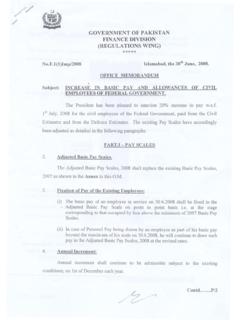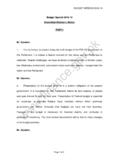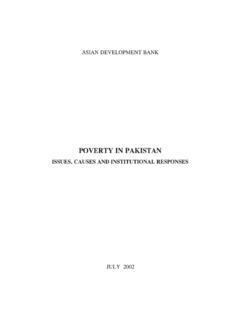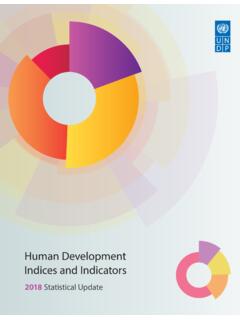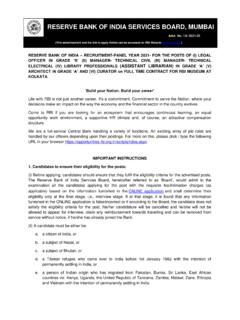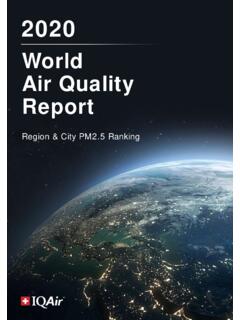Transcription of AGRICULTURE - Government of Pakistan
1 AGRICULTURE is still the largest sector of the economy of Pakistan in terms of labour participation and as such livelihood of the majority of the population directly or indirectly depends on it. However, during the last few decades, its contribution to GDP has gradually decreased to percent however there is a lot of potential in the sector to increase its share in GDP through increased productivity utilization of latest agricultural technologies. Being the sector engaging the largest workforce and providing raw material to most manufacturing sector, its development not only contributes towards achieving poverty alleviation but can also uplift socio-economic structure of a major segment of the population. During FY2020, the performance of AGRICULTURE sector improved over the last year and it also performed better than other sectors. However, the challenges due to climate change, pest attacks, shortage of water etc.
2 , kept AGRICULTURE production far less than the potential. One key issue related to AGRICULTURE is that the farmers have limited direct access to the market due to which the role of middleman remains crucial. And farmers normally do not receive fair market price of their produce. In terms of potential, AGRICULTURE sector has the capacity to not only produce for the domestic population but to have surplus production for exports, which can ensure food security as well as contribute towards foreign exchange earnings. Realising the potential of AGRICULTURE and taking cognizance of the challenges/issues related to AGRICULTURE , the present Government has introduced Prime Minister AGRICULTURE Emergency Programme worth Rs 277 billion to revolutionize the AGRICULTURE and livestock sectors. The objectives of the programme include improvements in water availability, soil conservation and shrimp farming. In addition, the programme also includes establishing new AGRICULTURE markets which will protect farmers from the exploitation of middlemen.
3 The programme s vision is food secure Pakistan , based on modern and efficient food production and distribution systems, can best contribute towards global stability and peace . The recent pandemic COVID-19 poses extraordinary challenges for almost all sectors of the economy of Pakistan . The need for maintaining food security and livelihoods has also gained more importance. The cereal markets are expected to remain balanced and comfortable despite uncertainties over the impact of COVID-19. As logistical issues may pose challenges to food supply it is important to take measures for boosting AGRICULTURE production which will contribute in mitigating the socio-economic impact of COVID-19. AGRICULTURE Performance during FY2020 Pakistan has two cropping seasons."Kharif", the first sowing season, starts from April to AGRICULTURE Chapter 2 Pakistan Economic Survey 2019-20 18 June and is harvested from October to December.
4 Rice, sugarcane, cotton, maize, moong, mash, bajra and jowar are Kharif" crops. "Rabi", the second sowing season, begins from October to December and is harvested from April to May. Wheat, gram, lentil (masoor), tobacco, rapeseed, barley and mustard are "Rabi" crops. Pakistan s agricultural productivity is dependent upon the timely availability of water. Performance of Kharif crops; Rice production increased by percent to million tonnes and Maize production by percent to million tonnes while Cotton production declined by percent to million bales and Sugarcane production declined by percent to million tonnes. Wheat is the most important crop of Rabi , which showed growth of percent and reached to million tonnes. Other crops having a share of percent in AGRICULTURE value addition and percent in GDP, showed growth of percent mainly due to increase in production of pulses, oilseeds and vegetables.
5 Cotton ginning declined by percent due to decrease in production of cotton crop. Thus, the crops sector, overall, experienced a growth of percent due to increase in growth of important crops by percent mainly due to sufficient availability of inputs (adequate water, certified seeds, pesticides, and an uptick in credit disbursement) despite lower fertilizer off-take. Livestock having share of percent in AGRICULTURE and percent in GDP achieved the growth at percent. The Fishing sector having share of percent in AGRICULTURE value addition (and percent in GDP), grew by percent, while Forestry sector having share of percent in AGRICULTURE (and percent in GDP) grew by percent. Thus, the performance of AGRICULTURE during 2019-20 remained remarkable. On the aggregate, the sector recorded strong growth of percent considerably higher than percent growth achieved last year.
6 (Table ) Table : AGRICULTURE Growth (Base=2005-06) (%) Sector FY2014 FY2015 FY2016 FY2017 FY2018 FY2019 FY2020(P) AGRICULTURE Crops i) Important Crops ii) Other Crops iii) Cotton Ginning Livestock Forestry Fishing P: Provisional Source: Pakistan Bureau of Statistics AGRICULTURE 19 During 2019-20, the total availability of water for the Kharif crops 2019 reached to million acre feet (MAF) showing an increase of percent over MAF of Kharif 2018 while it remained less by percent against the average system usage of MAF. During Rabi season 2019-20, the total water availability reached to MAF, showing an increase of percent over Rabi 2018-19 and percent less than the normal availability of MAF. (Table ). Table : Actual Surface Water Availability (Million Acre Feet) Period Kharif Rabi Total % age increase/decrease over the average system usage ( MAF) Average system usage - 2010-11 2011-12 2012-13 2013-14 2014-15 2015-16 2016-17 2017-18 2018-19 2019-20 Source: Indus River System Authority I.
7 Crop Situation The important crops (wheat, rice, sugarcane, maize and cotton) account for percent in the value addition of AGRICULTURE sector and percent in GDP. The other crops account for percent in the value addition of AGRICULTURE sector and percent in GDP. The production of important crops is given in Table Table : Production of Important Crops (000 Tonnes) Year Cotton(000 bales) Sugarcane Rice Maize Wheat 2013-14 12,769 67,460 6,798 4,944 25,979 ( ) ( ) ( ) ( ) ( ) 2014-15 13,960 62,826 7,003 4,937 25,086 ( ) ( ) ( ) ( ) ( ) 2015-16 9,917 65,482 6,801 5,271 25,633 ( ) ( ) ( ) ( ) ( ) 2016-17 10,671 75,482 6,849 6,134 26,674 ( ) ( ) ( ) ( ) ( ) 2017-18 11,946 83,333 7,450 5,902 25,076 ( ) ( ) ( ) ( ) ( ) 2018-19 9,861 67,174 7,202 6,826 24,349 ( ) ( ) ( ) ( ) ( ) 2019-20 (P) 9,178 66,880 7,410 7,236 24,946 ( ) ( ) ( ) ( ) ( ) P: Provisional (July-March), Figures in parentheses are growth/decline rates Source: Pakistan Bureau of Statistics Pakistan Economic Survey 201920 a) Important Crops i) Cotton Being a major cash crop of Pakistan , cotton is considered the backbone of the economy.
8 It contributes about percent to GDP percent of total value addition in AGRICULTURE . During 2019-20,was sown on an area of 2,527hectares, which increased by percentover last year s area (2,373hectares). Cotton production is estimated at around million bales, which is lower by percent over the last year sproduction of million balesTable and Figure ). Even though the overall area increased over last year, the overall performance remained below due tounfavourable weather and low water availability during important stages of plant development along with pest : Area, Production and YielYear Area (000 Hectare) 2015-16 2,902 2016-17 2,489 2017-18 2,700 2018-19 2,373 2019-20(P) 2,527 P: Provisional (July-March) Source: Pakistan Bureau of Statistics ii) Sugarcane Sugarcane is a high value cash cropsignificance for sugar and sugar related industries in Pakistan .
9 It contributes about percent to GDP and percentaddition in AGRICULTURE . During 2019sugarcane production decreased by million tonnes as compared to million tonnes of last year. The output may depict the pattern ofcultivation 1,040 thousand hectares compared to 1,102 thousand hectares, a decline of percent, with improved yields compared to 2018-19. The area, production and yield of sugarcane during thePakistan Economic Survey 2019-20 9917106711194698619000100001100012000201 5-16 2016-17 2017-18 : Cotton Production (000 bales)Being a major cash crop of Pakistan , cotton the backbone of the economy. about percent to GDP and value addition in 20, cotton crop was sown on an area of 2,527 thousand by percent (2,373 thousand s estimated at around million bales, which is lower percent over the last year s million bales (see Even though the overall area increased over last year, the overall performance remained below due torable weather and low water availability during important stages of plant development along with pest attacks.))
10 Table : Area, Production and Yield of Cotton Production % Change (000 Bales) % Change (Kgs/Hec)- 9,917 - 10,671 11,946 9,861 9,178 618 high value cash crop that has significance for sugar and sugar related contributes about percent of total value During 2019-20, sugarcane production decreased by percent to million tonnes as compared to last year. The output pattern of area under 1,040 thousand hectares compared to 1,102 thousand hectares, a decline of percent, with improved yields The area, production the last five years are given in Table and Figure 2016-17 2017-18 Fig : Sugarcane Production (000 Tonnes) 986191782018-19 2019-20 (P) : Cotton Production (000 bales)overall area increased over last year, the overall performance remained below due to rable weather and low water availability during important stages of plant Yield (Kgs/Hec) % Change 582 - 730 753 707 618 e and Figure 67174668802018-19 2019-20 (P)Fig : Sugarcane Production (000 Tonnes)Table : Area, Production and Yield of SugarcaneYear Area (000 Hectare) % Change2015-16 1,131 2016-17 1,218 2017-18 1,342 2018-19 1,102 2019-20 (P) 1,040 P: Provisional (July-March) Source.
